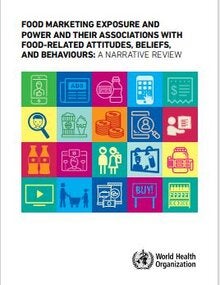Overview
This report presents the outcomes of a narrative review conducted to update an earlier descriptive review published by WHO in 2009 on the extent, nature and effects of food marketing. The current review was requested by the WHO Nutrition Guidance Expert Advisory Group (NUGAG) Subgroup on Policy Actions as part of the evidence reviews to inform its formulation of an updated WHO guideline on policies to protect children from the harmful impact of food marketing.
The review included 143 content analysis studies (studies that consider where food marketing occurs, how much there is, for which brands/products and what creative content and marketing techniques are used) and 36 consumer research studies (studies that explore individuals’ beliefs, attitudes, perceptions and behavioural responses to food marketing) published between 2009 and 2020. Based on the content analysis studies, food marketing remains prevalent, including in settings where children gather and during children’s television programming and viewing times. Food marketing predominantly promotes foods that contribute to unhealthy diets (such as “fast food”, sugar-sweetened beverages, and chocolate and confectionery) and uses a wide range of creative strategies likely to appeal to young audiences (such as celebrity/sports endorsements, promotional characters, and games). The findings of the consumer research studies included positive associations between the frequency of, or level of exposure to, food marketing and habitual consumption of marketed foods or less healthy foods.
This review extends the findings of the 2009 WHO review by adding evidence and perspectives on more contemporary types of marketing, reflecting the growth in internet use and food marketing via digital and social media over the last decade. It confirms that marketing of foods that contribute to unhealthy diets remains pervasive and persuasive and provides evidence that strengthens the rationale for action to restrict food marketing to which children are exposed.
|

